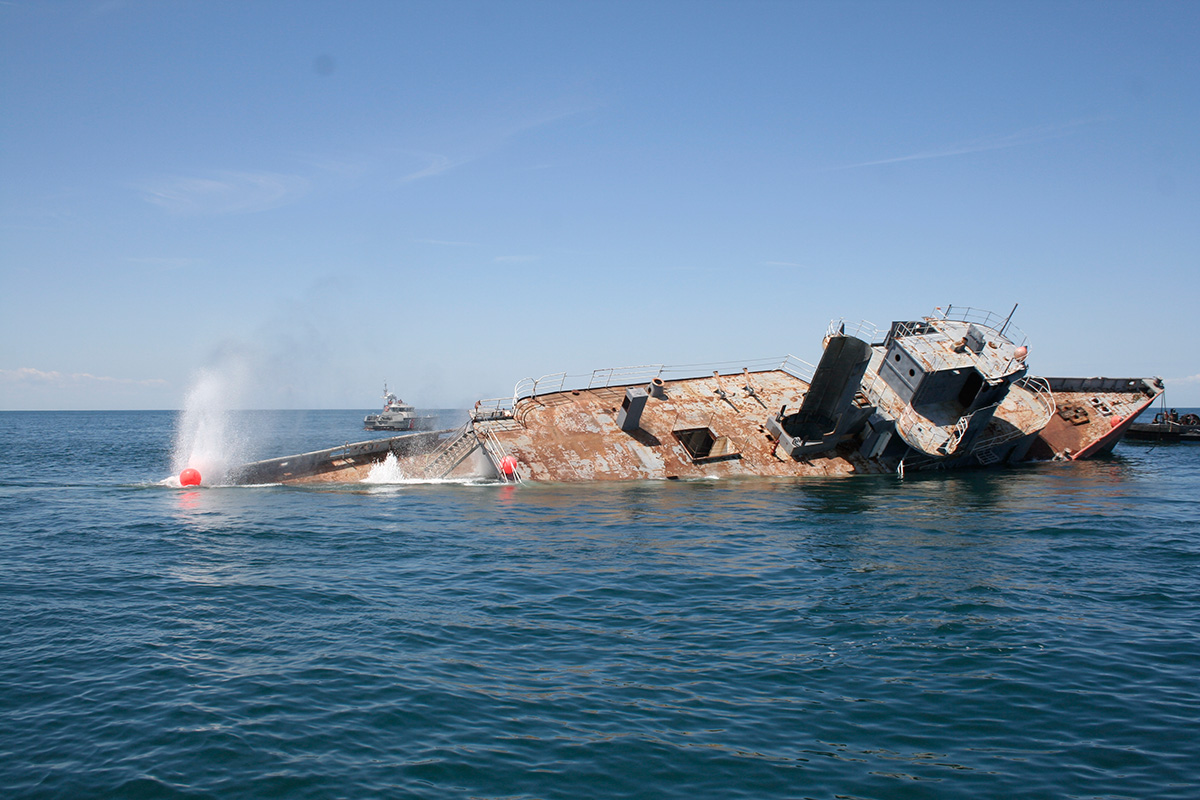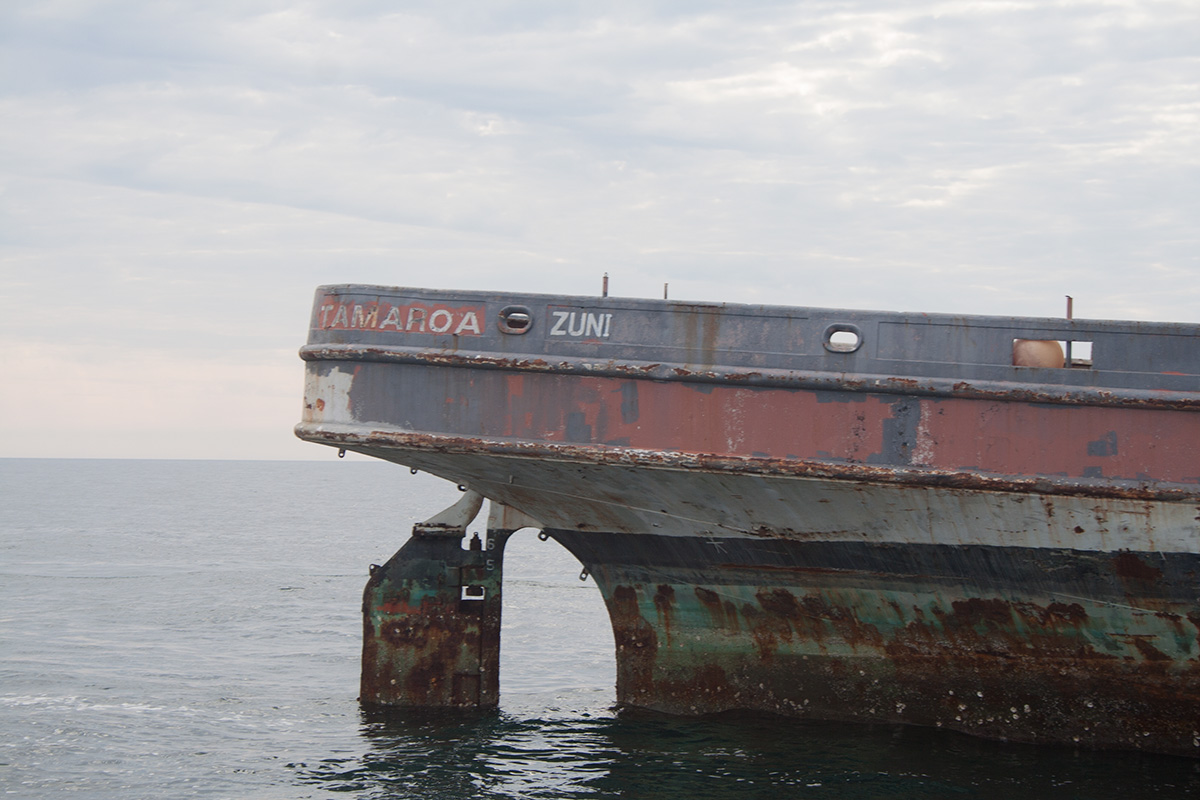
The ship made famous in the Perfect Storm is now helping produce perfect drifts for South Jersey and Delaware anglers.
There have been many ships that have served our country with honor and distinction with most ending up being cut up in scrap yards and sold in little pieces. That is what happened to my first ship, the USS Saratoga, CV 60. My second ship, the USS Lexington, CV 16, had a better fate; it is now a floating museum in Mobile, AL.
Back in 1943, during the height of WW II, the Navy built an ocean going tug and named it the USS Zuni. This ship served in the Pacific Theater and was there for the battle of Iwo Jima.
After the war, in 1954, the Zuni was converted to the Coast Guard Cutter Tamaroa. If that name sounds familiar, it’s the ship that saved seven of eight members of a National Guard helicopter rescue team that crashed into the ocean during the Perfect Storm. Capt. Kristopher Furtney deployed a cargo net along the side of his ship then laid her side-to the immense waves produced by the storm.
The ship took 52-degree rolls in those 40-foot seas and was buffeted by 80-knot winds. Fortunately, the maneuver was a success and the crew of the helicopter was able to grab the cargo net and were pulled to safety by the Tamaroa’s crew. The ship then spent the next 48 hours searching for the National Guard’s rescue swimmer, unfortunately without success.
Prior to being considered for an artificial reef, the Zuni/Tamaroa was in the process of being turned into a museum. That project proved too expensive, and the folks who were attempting the restoration had to give up.
Reef Preparations
Ultimately, the Zuni/Tamaroa was taken to Coleen Marine Shipyard in Norfolk, VA where it underwent extensive preparation to comply with the many regulations covering anything sunk in the ocean. All hazardous material had to be removed including wiring, paint, oil, fuel and insulation. Then holes were cut in the hull to let in water once the ship was towed to the reef site. Other cuts were started closer to the waterline and these were completed once the ship arrived on site.
On May 10, 2017, the Delaware Department of Natural Resources and Environmental Control (DNREC) leased a launch service boat out of Slaughter Beach, DE to carry members of the press and other interested parties, out to the Del-Jersey-Land reef where the Zuni/Tamaroa was waiting. If you have never been to a ship sinking before, as some onboard had not, you might expect it to go down right away. Such is not the case. The launch boat also had on a crew from Coleen Marine who had the job of finishing the work they started in Virginia.
Once deployed to the Zuni/Tamaroa these guys and one girl first started a big pump, the kind they use to pump water out of a ship to keep it from sinking, but this time the pump was pumping water into the ship. While this was going on, the welders were cutting out the rest of the holes along the water line so that once the pump moved enough water to lower the ship those openings would quickly finish the job.
When you sink a ship on an artificial reef you have to put it exactly where the permit said you would. To this end, Jeff Tinsman, Delaware’s artificial reef guru, used highly technical equipment to mark the spot. He had two concrete blocks tied together with a line that was secured at the other end to a red float ball. Jeff deployed this equipment when the captain of the launch told him the GPS indicated we were over the right location at 38 31.144N/074 30.747W.

Final Resting Place
In spite of this highly advanced technique there turned out to be a slight problem. In an effort to keep the ship close to the correct site the tug had to keep adjusting the ship’s location. During one of those moves something fouled the line to the concrete blocks and moved them. Jeff found out it is pretty difficult to pull that much weight up from the bottom in 120 feet of water. With a little help from his friends he got the job done and was able to relocate the rig to its proper location.
As the ship started settling down in the water, the crew from Coleen Marine began to disembark. The last one onboard had the job of untying the line from the tug to the ship. It would be a bit embarrassing to sink the tug still tied to the ship and it would have to be raised because it had not been properly prepared as artificial reef material.
This operation provided its own bit of entertainment. Once the main hawser was off, a lighter line from the tug to the ship had to be secured around the bow. A crewman from the tug attempted to toss the monkey fist up to the guys from Coleen Marine, but it took several tries before a successful connection was made. At each try and failure the jovial bunch on the launch booed, but when the man on the ship finally made the catch a loud cheer went up.
This line was used to move the ship as close as possible to the correct site just as it began to sink. At this point the line was pulled clear of the ship and it quickly went down. We arrived on site at 0830 and the ship slipped below the waves a little after 1300. It disappeared starboard side first then sank with the bow the last to go under.
The Coast Guard was well represented at the sinking with at least a half-dozen boats lined up around the ship. A Coast Guard helicopter did a fly over to honor the rescue swimmer lost during the Perfect Storm.
The Porgy, a head boat from Cape May, NJ carried a number of veterans to watch the sinking and there was a small boat from the New Jersey artificial reef program that was used to help the crew from Coleen Marine. I thought there would be more boats there given the beautiful weather and the publicity that preceded the sinking. Perhaps since sea bass and tog seasons were closed there was little interest in a 25-mile ride to watch a ship sink.
Financing Future Reefs
The money needed to sink the Zuni/Tamaroa came from recreational fishing interests. The Fisherman Magazine Sport Fishing Fund supplied 25 percent and the State of Delaware suppled the other 75 percent using fishing license money and in kind matching funds. Once again Jeff Tinsman has been able to build an artificial reef without using any tax payer’s money.
Delaware currently has 14 reef sites and all have been constructed with money from recreational fishermen either through the general fishing license or the excise tax paid by fishermen for their equipment. This is the reason Delaware was able to receive special designations for our artificial reefs in federal waters. Since the reefs were built with recreational funds, commercial fishing, other than hook and line, is prohibited. Currently, the Mid-Atlantic Fishery Management Council is in the process of reviewing a Special Management Zone (SMZ) request from the New Jersey Department of Environmental Protection to enact the same gear restrictions for 13 of New Jersey’s artificial reef sites located in federal waters out beyond 3 miles.
The Fisherman Magazine’s Sportfishing Fund is now a private 501 c3 Corporation headed by Brian Nunes-Vais. Now known as the Sportfishing Fund, Nunes-Vais hopes to increase the amount of money available for projects such as artificial reefs by attracting corporate donors and grants from large trust funds as well as individual donations from concerned citizens. You can find out more about this organization by going to www.thesportfishingfund.org.
The Zuni/Tamaroa is not the first military ship sunk at the Del-Jersey-Land Reef. A few years ago the USS Radford, a Navy destroyer, was placed on the bottom and this spring when sea bass season opened it was the place to be. I was able to get out there in late May and we filled a 10-person limit of 150 fish rather quickly.
The Navy minesweeper, USS Cruise, and then menhaden boat the Gregory Poole and the menhaden boat Atlantic Mist are also at the Del-Jersey-Land Reef complex. In addition there are 288 New York subway cars scattered around the site. The next ship scheduled to join these will be a Delaware Bay ferry. Jeff Tinsman had a gleeful expression when talking about all the fish that could call this big vessel home. The Delaware River and Bay Authority will sell the ferry to Coleen Marine for $250,000. Once all the work is done to prepare the ship for sinking, Coleen Marine will sell the ship back to Delaware for $250,000 plus the expense of preparation. All of this is done to avoid insurance hassles. The project is scheduled for completion in 2018.
A ship with as glorious a record as the Zuni/Tamaroa should not be sold off as scrap and since making it into a museum was cost prohibitive, I believe having it as part of an artificial reef will allow the ship to continue its service to America, and I was honored to be there when it assumed its new duty station.




